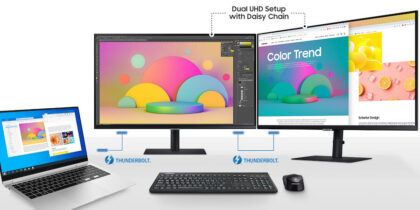Today, Samsung Electronics has announced a new partnership with IGEL, a thin client technology leader. With this new partnership, Samsung is expanding its cloud monitor portfolio with the release of two new thin client displays that provide a reliable and efficient desktop solution for accessing the cloud.
What Are Thin Clients?
A thin client is a lightweight computing device that is purpose-built for remoting into a cloud server or desktop virtualization environment. Given that the user desktop software resources are virtualized in the data center, the majority of software execution takes place on the host server or server farm. What is unique about thin clients is the fact that they are multiprotocol devices. This means that thin clients can establish cloud-hosted user sessions with a variety of different virtual desktop environments such as Microsoft RDS (Remote Desktop Services), Citrix XenApp or Xen Desktop, VMware Horizon and others. This is accomplished with native protocol agents such as ICA/HDX, RDP/RemoteFX, PCoIP and web clients. Thin clients can even take on local multimedia rendering to optimize client-server performance. All of these capabilities are normally prepacked on a small-footprint, read-only OS layer that minimizes client-side administration and security risks. As a result, thin clients offer extensibility not found in other cloud computing devices such as zero clients, even though zero clients still play a big role in more specialized use cases.
Thin Client Management Tools
Thin clients dramatically reduce client-side administration, but cloud connection properties are diverse from one user population to another, and server-side updates occasionally trigger agent updates on the client. While property changes and firmware updates are relatively rare, managing them can be extremely impractical and time-consuming when done manually, especially if an organization is managing hundreds or even thousands of thin client devices. Thin client management tools can help to automate these changes remotely.
The new Samsung thin client displays, powered by IGEL Linux, are licensed for IGEL’s UMS 5 (Universal Management Suite 5) thin client management software. UMS 5 enables remote administration of all required management tasks, helping to minimize support costs and ensuring that administrators aren’t tied up performing menial tasks. It also ensures reliability and security by encrypting communications, enforcing access rights, ensuring proper authentication and providing backups.
When a thin client is first provisioned, the thin client management software can automate setup with the required profile when the device is attached to the network and can remotely change and update settings if and when needed. All changes can be made in the data center, meaning that personnel don’t have to visit each device in order to manage them. Changes can also be made more quickly, reducing downtime and keeping users productive. In the case of Samsung’s new thin client displays, this means that the monitors will rarely have to go offline, especially since maintenance can be scheduled for off-peak hours.
Benefits of Thin Clients
Thin client monitors are increasingly being used in a range of different industries, from retail and hospitality to healthcare and education. For example, in healthcare, thin clients are often preferred over PCs since they are nearly immune to malware and tampering, when combined with smart card or SSO (Single Sign-On) solutions, and can allow a user to access their profile from any device since critical user data is not stored on the device, but rather on the server back end.
With this new partnership, organizations will be able to more efficiently manage large fleets of thin client devices throughout their operations and facilities, providing many advantages in terms of productivity, security and cost. With more organizations turning to the use of thin clients, as well as cloud-based solutions, these new monitors from Samsung, powered and managed by IGEL’s software, will appeal to organizations in a variety of industries.
As cloud services become more popular, cloud security becomes even more important. Follow these tips to protect your organization against a breach.






